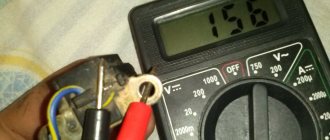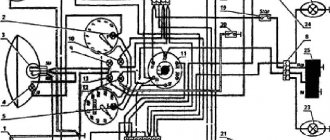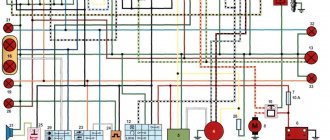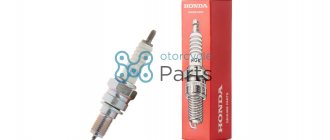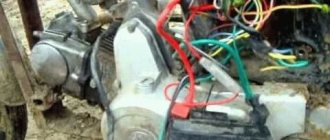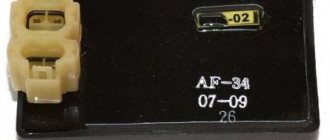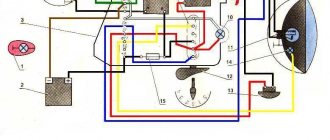Hello motorcycle masters!
No spark on dio 34 is a common problem. This topic is mostly discussed on forums, without specifics. Therefore, I decided to collect and present my experience on this topic in a general article for those who themselves want to understand and identify the reason for the lack of spark on the scooter. This principle can be used for Honda Dio 35, 27, stroke, 18, as well as for other 2t mopeds and scooters. Finding an electrical fault is much easier with a moped wiring diagram. But if the scooter is rare, then you can use a circuit diagram of a similar model from the same manufacturer.
Honda dio 27 starter connection diagram
Scooter diagram a selection of eight diagrams of different models HONDA Dio AF18 AF27 AF28 SK50MJ
electrical diagram of Honda Dio Honda (
Dio SK 50 Mj ). 1 - brake light switch, 2 - starter switch, 3 - light switch, 4 - ignition switch, 5 - starter relay, 6 - battery, 7 - voltage regulator (rectifier), 8 - fuel level sensor, 9 - level sensor oil, 10 — right-rear turn signal, 11 — brake light and tail light, 12 — left rear turn signal, 13 — spark plug, 14 — breaker (CDI unit), 15 — starting enrichment, 16 — generator ,
17 — electric starter, 18 — resistor, 19 — horn, 20 — headlight switch, 21 — turn signal switch, 22 — horn switch, 23 — turn signal relay, 24 — left front turn signal, 25 — headlight, 26 — right front turn signal, 27 — instrument cluster, 28 — backlight lamp, 29 — fuel level indicator, 30 — oil level warning lamp, 31 — overspeed warning lamp, 32 — 7A fuse, 33 — ignition coil.
You can see the rest of the scooter elements here:
Source
Checking the regulator-rectifier and voltage generator
Disconnect the battery. We switch the device to 10 A. We put the red probe on the c/h wire, and the second probe on the minus wire - the green wire. Turn on the ignition. We pull the kickstarter leg. The device can show 5 - 10 A. This means that the voltage generator, regulator-rectifier, electrical wiring and fuses in the circuit from the generator to the battery are working.
If all this works, but there is no spark, then all that remains is to check the switch. It cannot be disassembled and has a complex electronic circuit inside. Therefore, it can only be tested on another similar working scooter. Finding a Japanese switch can be difficult. But there are many Chinese analogues, they work no worse than the original ones.
This troubleshooting sequence - no spark on dio 34, can be used on any 2t or 4t scooter or moped. All you need is an electrical circuit for the scooter, a universal set of screwdrivers and wrenches, and a multimeter (tseshka).
Those who are interested will be able to find the problem with the spark on their scooter or moped and fix it with their own hands.
If you have any questions, write. We'll figure out.
: Adjusting the fuel level in the scooter carburetor
First of all, engine power drops. This can also be observed due to wear and tear of the engine systems.
The cylinder piston group may require replacement. However, an incorrectly configured carburetor can also affect the power of the engine. If it introduces more air into the mixture than required, the fuel becomes lean. This leads to overheating and reduced power. If the engine refuses to work at all, this may also be evidence of improper carburetor operation.
However, to find the cause of the breakdown, you will need to check several major systems. If the engine starts but stalls, this may be due to a clog in the carburetor. In any case, the driver must responsibly approach the issue of solving any problem related to his vehicle.
Checking the ignition coil
Disconnect the battery and remove the beak on the scooter. We disconnect the connector on the switch and measure the resistance on the coil with a meter. We put one probe in the connector on the black wire, and the second on the negative (green wire). There should be 4 ohms - this means that the wiring and the primary winding of the coil are working properly.
We check the second winding of the coil. We take out the probe from the contact of the green wire and insert it into the candlestick instead of the candle. And we leave the other probe on the contact of the h/w wire. The resistance should be about 7.85 kOhm. This indicates that the second winding, the armored wire and the candlestick itself are in good working order.
Let me remind you that the armor wire and the candlestick separately from the coil have a resistance of 5 - 8 kOhm. Such resistance is needed to suppress radio interference from the spark discharge, so as not to interfere with others listening to the radio in the car or at home. If you make an armored wire and a candlestick without resistance and drive next to someone who is listening to the radio. Then the radio stops working normally and begins to crackle in time with the spark discharge on the scooter (moped).
And if the device shows a break (i.e. does not react at all), then remove and check the candlestick and armored wire separately. If they ring, it means a break has occurred in the ignition coil. It cannot be repaired, it is solid, you will have to replace it with a new one. It's inexpensive and you can always buy it without any problems.
Honda Tact scooter ignition system video
Honda Tact: not start
Should Chinese generators have an additional ground wire? Now we check the resistance of the secondary winding. Just check the wiring:
Auto Club - Video about cars. Honda Tact scooter ignition system video. Honda Dio 27…
Muffler from the launcher, zero resistance filter, variator also with traces of tuning. Let me note right away that other models from other manufacturers equip their scooters with similar coils, but the readings may differ, so these measurements can only be attributed to experimental specimens.
To get to the ignition coil, remove the toilet, disconnect the spark plug cap from the spark plug and move further from the cap along the high-voltage wire. Will there be such a corps de ballet because of this? It rarely starts, only at ignition the Honda has difficulty with the throttle and does not develop speed, no matter how hard you turn the trigger.
We adjust the contactless ignition system
The contactless system operates through a sensor, switch, primary and secondary ignition windings. When the rotor with magnet closes the sensor, it sends a signal to the commutator, which, in turn, begins to accumulate current from the generator and transmit it to the primary winding. At this moment, high voltage appears in the secondary ignition winding. Its purpose is to ignite the spark. If there are any malfunctions listed above, adjustment is carried out by simply aligning the crankcase and ignition marks; to do this, remove the valve cover. The next steps are:
- We disassemble the crankcase in accordance with the technical description for your car.
- A mark is made on the rotor and crankcase at the dead center position of the engine in a place convenient for viewing.
- By rotating the crankshaft, we achieve a spark, make a mark on the crankcase relative to the mark made on it in the MTD. The difference between these marks on the crankcase is the ignition timing.
- Unclench the stator mounting bolts and set the advance angle corresponding to the technical documentation.
It is important to ensure that two of the three holes in the gear for the chain are at the level of the cylinder, and the remaining one is above the plane in which the cylinder and the mentioned holes are located. The alpha moped has a reliable ignition system, but it can also break; you should not put off this breakdown and ride on a faulty moped
You just need to try setting the ignition. You can set the ignition yourself if you have special tools and minimal skills. If this is not the case, then it is best to contact a specialist.
The Alpha moped has a reliable ignition system, but it can also break; you should not put off this breakdown and ride on a faulty moped. You just need to try setting the ignition. You can set the ignition yourself if you have special tools and minimal skills. If this is not the case, then it is best to contact specialists.
Search
Troubleshooting Honda DIO Motorcycle Ignition System
And so we remove the plastic and look for elements of the ignition system. Finding a switch is not difficult: it is a small, mostly black plastic box with connectors that fits 5 or 6 wires of different colors.
It's even easier to find the ignition coil: a thick high-voltage wire leads to the spark plug. The generator and electromagnetic sensor are located in the engine housing, but can be checked without disassembly.
To find out what happened, you need to know how the electric scooter system works.
Voltage is supplied from the generator to the switch and accumulated in a capacitor. The electromagnetic sensor transmits a signal to the capacitor, and it instantly discharges, and all the current flows to the ignition coil. The current from this capacitor increases sharply by several thousand volts and passes through a thick high-voltage wire to the spark plug. There is a wire from the switch to the ignition. It serves to shut down the engine. When the ignition is turned off, the wire shorts to ground. You need to check all these diagrams.
Take a digital multimeter and adjust it to measure resistance. Make sure the motor is in electrical contact with the moped frame.
You may also like
Then determine the value of each wire corresponding to the switch connector.
It is better to start with wire “mass” (often green). There should be zero resistance between this wire and the scooter frame. Two wires go to the ignition coil: one goes to ground, the other goes to ground. to the switch. Look at the color of the switch wire (this can be found in the switch connector).
We disassemble the front plastic part of the scooter, also called the “beak”. Remove the ignition interlock cover.
Select the wires that match the ignition. This wire, which matches the color of one of the wires going into the switch, is the scooter bend. It remains to determine the purpose of the two wires. from the electromagnetic sensor and from the power coil. A black wire with a red stripe is usually located from the electromagnetic sensor
, and others. from the power coil. To make sure we are not mistaken, we measure the resistance between these wires and ground: the resistance of the electromagnetic sensor is two to three times greater than the resistance of the high-voltage winding of the generator.
Time Scooter
scooter
won't start.
Honda Dio 27 will not start
Video. Scooter
-ignition
system , diagram, operation, clear, simple language. accessible for beginners. Knowing the operating principle
The best way to test components is by measuring the resistance at the terminals of the wires leading to the switch. Just check the wiring: it often happens that it breaks the electrical circuit. If your resistance meter shows infinite resistance on one of them, then as you “move” along the wire you will find an open circuit.
You may also like
Start moving from the candle cap. When looking inside, make sure that the spring on the contact is not lost, and that the cover itself is placed on the spark plug with noticeable difficulty (if the fastening is poor, the engine will run intermittently).
Make sure the secondary winding is working properly by checking the high voltage wires from the spark plug cap. Remove the spark plug cover and check the resistance between the terminals: put on the spark plug and ground. It should be somewhere around 7.5 ohms. Now remove the cover from the wire and determine the resistance between ground and wire. should be about 2.5 ohms. Therefore, the resistance of the noise suppression resistor is 5 ohms.
If after the test you find that you need a new high voltage wire, buy only one with a metal core. Automotive high-voltage wire with a carbon core is not suitable here!
Now let's move on to the ignition coil. We need a digital voltmeter here. resistance secondary winding
A small and pointing device distorts the received data. We check the resistance between ground and the wire that goes to the coil.
This has its own peculiarity. If you cover the leads of a digital ohmmeter, it will usually read more than zero. Remember how much it read and subtract that value from the reading when checking the ignition coil. The difference should be approximately 0.2-0.3 Ohm. primary winding resistance.
Next we check the engine shutdown circuit. We connect the multimeter to the wire going from the switch to the ignition switch. Turn the ignition key to the off position. The device should show zero in the initial position. infinity.
So, we have an electromagnetic sensor and a generator winding. We find a black wire with a red stripe in the switch connector, measure the resistance of this wire with a multimeter relative to ground: it should be 500 Ohms. This is a necessary sensor. Strong resistance winding wire (preferably blue with a white stripe). 150-200 Ohm. If the resistance value is much lower, there may be an internal short circuit within the power coil. In this case, it no longer provides the correct voltage for the spark. If you have any doubts about the performance of this item, please contact the workshop. To remove and diagnose the generator, special equipment is required. If you try to disassemble the generator yourself. you might break.
Pinout
If you have a 4T motor installed on your scooter, the pinout of the switch will depend on what type the scooter requires. For DC it will be as follows:
The leftmost terminal on top should connect to the generator sensor. Ground is connected to the terminal located under it.
You can tie the negative wire, for example, to the body of a moped; it is important that the part is metal. The upper terminal, located in the center, is connected to the wire leading to the ignition coil drive. The one located under it is also connected to the negative wire (ground). The wire from the ignition switch is connected to the upper rightmost terminal, which is needed to turn off the engine. The power wire is connected to the terminal located under it; it also comes from the ignition switch. If you have an AC type, the location of the terminals is the same, but they are connected differently:
If you have an AC type, the location of the terminals is the same, but they are connected differently:
- We move from left to right, first the top row, then the bottom.
- Here the wire from the generator sensor goes, as in the previous version.
- Next comes the ignition coil wire.
- And at the end there is a “silencer” for the ignition switch.
- The first two terminals are the negative wire, “ground”.
- To the last remaining terminal we connect the power wire from the high-voltage winding of the generator. This point is the main difference when connecting an AC switch from a DC one.
Scooter Honda Dio AF 18 27
The Honda Dio AF 18 has a slightly different switch, made in Japan, which is why the pinout of the scooter is a little unique, and the mounts on the switch are different. It is connected as follows: from left to right, first the upper, then the lower terminals. Location:
- Hall Sensor.
- Ignition coil.
- Weight.
- Ignition lock.
- Power wire from a high voltage coil.
Yamaha Jog Scooter
Several types of generator can be installed on this type of motor vehicle. The most common option has 5 contacts, with wires already coming out of it. Therefore, if you have original wiring, you need to connect as follows:
- Orange should lead to the ignition coil and alternator.
- Black - to the ignition switch.
- Purple – Hall sensor.
- The remaining two wires are connected to the ignition coil.
Chinese scooters
Typically, such vehicles have standard switches, which were described above. The connection diagram depends on whether the AC or DC device is installed on your vehicle. It is worth remembering that different types of switches are not interchangeable.
What is advance ignition
The quality of the mixture supplied to the engine cylinder determines the behavior of the scooter in cold weather, as well as how high the wear of the cylinder itself will be. For example, with a rich mixture, the engine starts better, but carbon deposits form; with a lean mixture, the cylinder quickly wears out and traction is lost.
In order to facilitate the process of starting the engine, you can set the ignition to advance, this will make it easier to start the engine regardless of the weather outside, slightly increase engine power, and significantly increase traction. The peculiarities of such settings are that a charge is formed in the spark plug before the piston reaches the dead center. This makes it easier to start the engine and increases engine power. However, it is worth remembering that cylinder wear may increase.
The procedure is carried out in approximately the same way as a regular ignition adjustment, but has its own nuances. To do this, all the same actions are carried out, only the tags are not completely connected. The discrepancy should be approximately half a centimeter. This is enough to get the desired effect.
How to set the lead angle (video)
Checking the Pulse Generator
We measure the resistance of the Hall sensor coil at the switch connector. We set the device to 2 kOhm. We connect one probe to the green wire, and the second to the s/w. Should be 114 ohms. This means the wiring and Hall sensor are working properly.
If the circuit does not show resistance, then this indicates a break in the coil or electrical wiring from the pulse generator to the switch.
Next, we check the functionality of the entire pulse generator along with the mechanical part. Switch the device to 2 mA, leaving the probes in place.
We pull the leg of the kickstar. From the Hall sensor, for one rotation of the magneto, one pulse with a small current is supplied to the commutator. The meter should show approximately 0.6 mA. This means that all elements of the pulse generator are working properly and the reason for the lack of spark is not in the Hall sensor.
If the device does not show current, then you need to remove the air cooling casing. Look at the gap in the mechanical part of the generator, between the magneto and the Hall sensor. Check to see if the crankshaft bearings are loose or if the wire from the sensor is broken.
Scooter electronic ignition device
The modern ignition system of a 4t scooter is designed as follows: the switch and coil, which are its main elements, supply high voltage to the spark plug, which generates an electrical discharge that can ignite the fuel. The coil generates high voltage due to electromagnetic induction. The switch is needed to distribute its interruption voltage at the right time. Inside there is an electronic circuit, a thyristor and three outputs for wires. At the right moment, the switch supplies voltage or turns it off.
The principle of operation of the scooter ignition system is as follows: the battery supplies voltage to the coil, which is often connected to a switch in one unit, the switch supplies voltage to the spark plug, and decides when to interrupt it. The mixture in the cylinders lights up at the right time. The correct operation of the engine and whether it will start at all depends on how the ignition is configured and set.
Switch
In many scooter models, the commutator is combined with a coil, so if one of the devices fails, the entire unit has to be replaced. Such spare parts are inexpensive.
Externally, the switch looks like a plastic box. Inside there is a microcircuit, a variety of electronics that cannot be repaired. In addition, there is a thyristor. The task of this element is to interrupt the electrical impulse at the right moment; for this purpose it has three outputs. When current enters one of them, the thyristor turns into a conductor, and the current moves from the input contact to the output. When a certain voltage is reached and the current drops, the pulse is interrupted, after which the Hall sensor returns the thyristor to its original position so that the signal arrives again at the third output. The process is repeated every time the voltage is applied again.
Delta moped wiring diagram china
The electrical circuit diagram of Chinese scooters is shown in the figure:
As with other electrical connections, there is a common wire on all cube mopeds. In this diagram it is the negative tire running along the entire body. The corresponding battery terminal is also connected to the scooter's frame, ensuring that each electrical component's ground is in constant contact with the power source.
Electrics and electrical equipment of a scooter
The main components in the 4t moped circuit are:
- central locking;
- battery charging source – generator;
- voltage limiter;
- spark formation and control systems;
- control elements for headlights, brake lights, turns;
- fuel level indicator in the tank.
Depending on the modifications and dimensions of the scooter, the instrument panel may include a tachometer - a device for monitoring the number of engine revolutions.
All of the listed nodes of the general scheme perform a strictly assigned role. Failure of at least one of them leads to the cessation of operation of the connected devices. Therefore, monitoring the serviceability of the main elements must be done every certain period for the purpose of prevention.
Communities › Around the wheel (motorcycles, ATV, jet skis) › Blog › Ignition of Honda dio af34
Hello everyone! Please help me with a diagram for a Honda Dio af34, there are different diagrams on the Internet, there is no Honda nearby to call which wire is which. I set this ignition to 139 qbm in order to remove the switch at the changeover and install a 12-coil stator. I found that everything is more consistent with this scheme
Is it true? I'm just buying a new switch, I don't want to burn it. And another question, in stores they sell a switch like this
Is it normal that the double chip is on the other side? I understand that the switch is Chinese, this is for testing, if everything works, I’ll order the original from Ebay.
Thursday, September 28, 2021
Carburetor diagram for 139qmb
| Carburetor outlet channels. “Fuel injection channels” - used at the moment of opening the throttle valve, that is, they are used as transition channels at the moments of closing/opening the valve |
Throttle valve limit screw.
Information from a post on one automobile forum regarding the same screw, but on a car carburetor:
But what about this (quote from the Daewoo Nexia primer): . The initial position of the throttle valve when the accelerator pedal is released is adjusted and fixed with a limit screw at the factory. This damper position provides sufficient air flow in the intake manifold to install the IAC shut-off element in the required discrete position during automatic frequency control. It should be noted that in relation to this engine, the initial position of the throttle valve cannot be considered as the position corresponding to the minimum idle speed. The head of the idle speed limit screw is closed with a cap. Warning It is prohibited to remove the protective cap of the limit screw and make adjustments. Incorrect adjustment may result in damage to the IAC or throttle body. .
| The throttle stop screw is not intended for adjusting idle speed! This screw limits the movement of the damper to prevent it from wearing out/jamming. |
| According to the manual, the standard setting for the idle speed adjustment screw is two turns +\- 1\4 |
Check all O-rings for damage. Replace if necessary. A poor seal at the seat of the enrichment valve has a very negative effect on the stable operation of the carburetor and, accordingly, the engine.
When cleaning the carburetor, remove the vacuum diaphragm before using purge air or cleaning solvents. This will prevent damage to the diaphragm.
Excellent video with an animated demonstration of the carburetor:
Possible malfunctions of the CVK carburetor
1.The engine is difficult to start
— No spark - Poor compression
2. There is no fuel in the carburetor
-Closed fuel line -Closed fuel filter -Blocked vacuum line -Damaged/broken vacuum line -Clogged inlet needle -Float level set too high
Float level: with this position of the float, the needle should just close the fuel line.
| The carburetor is in an inverted state, the float presses on the needle with its own weight. The measurement was taken from the center of the protruding seam of the float and to the horizontal plane on the carburetor body, photo below. |
| reference points for measuring the position of the float |
It is also worth paying attention to the needle itself and the float. It has a spring-loaded stop, or rather a rod, through which the float tongue presses on the needle
So, when adjusting the carburetor or repairing it, you need to pay attention to this emphasis. It happens that when the equipment is idle for a long time, this spring-loaded rod gets stuck and it does not play on the spring. If this happens, you need to develop it using liquid keys or diesel fuel. If the rod turns sour tightly, it is better to replace the needle.
In a strictly horizontal position, the protruding line on the float and the line on the exhaust tract of the carburetor, the spring-loaded stop of the float needle should take the middle position.
3. Too much fuel for the engine
-Dirty air filter -Air leak in the intake manifold -Faulty enrichment valve ( jammed or bad seal at its seat)
) -The air channel in the carburetor is blocked
4. Air/fuel mixture too rich or too pale
-The enrichment valve is faulty ( jammed or bad seal at its seating location)
) -Idle screw too tight -Float needle stuck or dirty -Float height too high or too low -Carburetor air passage blocked -Air filter dirty -Carburetor or manifold leaking air
5. Engine does not accelerate
-Bad spark -Air mixture screw too tight -Accelerator pump faulty
6. Almost does not respond to the throttle
-Weak spark/poor ignition -Blocked fuel line -Blocked fuel filter -Bad fuel -Water in fuel -Air leak in carburetor or manifold -Faulty enrichment valve -Fuel movement in carburetor is difficult -Vacuum choke stuck -Damaged vacuum diaphragm -Dirt in carburetor
Generator
Owners of 50cc who are familiar with the design of the scooter will immediately understand the purpose of this device. It produces an alternating electric current that powers the moped when the engine is running. But the second main task is to charge the battery while working. That is, the battery ensures the operation of the devices when the engine is turned off, and then the generator takes on this task.
The connection is made according to the following principle. There are several wires coming from the generator. The negative tire is attached to the frame of the scooter. There is alternating voltage on the white wire, which is immediately sent for rectification and stabilization.
In the electrical circuit, the yellow wire powers the low and high beam lights. Additionally, a Hall sensor is located in the generator housing. Its task is to generate impulses to control sparking. It is not electrically connected to the generator; it is connected to a white-green and red-black wire. The sensor is connected to the CDI block.
Types of scooter switches
Before connecting the switch, it is important to know what type your scooter requires. If you connect the wrong device or do it incorrectly, the switch will immediately fail. The problem is that the part has the same plugs, but you can tell them apart. It's worth starting with the fact that DC is much larger in size.
AC CDI is much more common. It is installed on most Chinese and some Japanese vehicle models. Most often, such a switch is found on those scooters that have a 139QMB or 157QMJ engine.
A slightly different AC switch is installed on “Alpha”, “Delta” mopeds, and other equipment with a 1P39FMB motor. Such a switch operates from a generator coil and requires alternating voltage
DC has a different type of power supply - from a battery, so it has
12V, and if you connect it to a generator, the switch will break. AC is more durable in this regard; most likely, it simply will not work until you connect it correctly.
The principle of operation of ignition in a 4-stroke scooter engine
Modern scooters are equipped with contactless systems. They are considered the most reliable and easy to use, do not require complex connections, and provide a constant good spark on time. However, the setting is still important; even the presence of a spark does not always allow the fuel mixture to ignite, since its power also plays a role.
The main reasons for the operation of the ignition system are quite simple: its task is to create a spark to detonate the fuel mixture. If this does not happen, you need to carefully examine each node and find out why the spark disappeared.
- In order to check whether there is a spark at all, you need to unscrew the spark plug and apply it to the engine ground; this can be done using metal objects that are not covered with paint. You cannot hold it with your hand: if there is a spark, it can give you an electric shock, and the discharge reaches 40,000 volts, which the coil creates.
Broken ignition is the cause of engine failure
An incorrectly configured or faulty ignition often causes engine failure. It would be wrong to immediately climb into the cylinder and examine the insides of the scooter, especially since this will not solve the problem. Before touching the ignition system, you need to check for other reasons why the scooter may not work.
- The simplest thing is the lack of gasoline in the tank. Quite often, owners forget to refuel their vehicle, and such a trivial reason can be overlooked.
- The carburetor may be clogged, which prevents the formation of a mixture suitable for driving.
- The carburetor needs to be cleaned regularly, so it doesn't hurt to check whether fuel is flowing from it into the cylinder. It is possible that the fuel pipe is clogged. The jets and other parts of the device may become clogged with debris, which causes little fuel to flow or, conversely, the engine does not have enough air, and therefore it does not start.
- The scooter may also refuse to start if the fault is caused by spark plugs. They may be wet or not produce a normal spark. It is advisable to have a spare set and check with it. In any case, the spark plug needs to be unscrewed and inspected.
Relay regulator
This is the same rectifier that converts alternating voltage to direct voltage, with a range of 13.5-14.9 V. C
.
The regulator is located under the plastic cover of the scooter at the front. It is attached to a metal backing for better heat dissipation.
The main circuits of the relay circuit are:
- The green wire is common.
- Red – output of converted and stabilized voltage within the established limits.
- White and yellow – AC input to the regulator. Due to electronics, the voltage is converted into powerful impulses. The yellow wire supplies power to a heavy load on the on-board network - headlights and instrument panel lighting.
The current for lamps is not stabilized, but is limited to acceptable values. At high generator speeds, the voltage goes beyond the operating ranges of the lamps, which leads to their burnout. The situation is very familiar to those who have encountered faulty relay regulators.
Because of one unit, you can lose all the light bulbs in a matter of seconds, so you should monitor the on-board voltage regularly.
How to set the ignition on a Honda Dio When choosing, pay attention to the presence
Ignition on Audi Alexander Category: Setting the ignition of the Audi 80 is carried out according to 3 marks: Then, designed specifically for asphalt, the car, along with certain basic cars, began the new era of parquet jeeps. For the base we took the Honda Civic, and the name of the car itself stands for Comfor. 2 Honda Dio 27 fit the ignition coil. How to set the ignition Look at the color of the commutator wire, you can find it in the commutator connector.
Remove the protective cap from the ignition switch. Select the wires that go to the ignition switch.
The wire that matches the color of one of the wires that goes to the switch is the wire silencing the scooter. It remains to determine the purpose of 2 wires - from the electromagnetic sensor and from the supply coil.
The black wire with a red stripe is usually from the electromagnetic sensor, the second is from the supply coil. The ignition timing on the scooter does not start. Honda Dio 27 won't start Video.
How to set the ignition on a Honda Dio scooter
Scooter ignition system, diagram, operation, clearly, in simple language - accessible to beginners. Knowing the principle of operation. Elsheep-Team Honda Accord 8. In any case, it is positioned that way.
One of the standard configurations has a very extensive audio system.
How to correctly adjust the ignition on a VAZ Most car owners who have a VAZ car may have encountered difficulties associated with the correct operation of the engine. A common problem is that turning the engine key starts it, but the engine does not respond correctly to idle ignition.
JavaScript is disabled in your browser
Let's try to figure out the reason in How to Disassemble the Ignition Switch of a VAZ The ignition switch of a VAZ The ignition switch in a VAZ car, like on any other, is designed to switch electronic circuits and turn on the starter. Because Honda Dio 27 how to set the ignition is out of order, then you can no longer start the car. There is no fundamental difference in adjusting the ignition in the engine of a scooter, moped, motorcycle, lawn mower or chainsaw.
The process of setting the ignition is not complicated, but it is responsible.
Ignition may be early - this is the case if the fuel-air mixture is ignited by a spark plug when the piston has not yet reached top dead center. The piston moves upward, and the expanding gas is already hitting it. Agree, it's a bad situation. Ignition can also be late, this is when the piston has already moved far down from top dead center.
In this case, the mixture may ignite as it passes through the exhaust ports of the cylinder. The correct moment to ignite the mixture is when the piston has only minimally moved down from top dead center. Typically, this value is indicated in the equipment manual and ranges from two to four.
How to set the ignition on a Honda Dio 27
Depending on the engine design. Ignition can be contact or non-contact. The contact one is installed on older models of motorcycles and mopeds, so we won’t talk about it.
Anyone interested can find it online on their own.
Modern scooters are equipped with contactless and electronic systems. If in a contact system the current is interrupted mechanically, by closing or opening the circuit, then in a contactless system the principle of operation is slightly different, although they are similar.
In any case, the low voltage electric current is generated by the generator.
A wire is connected to the ignition switch from the switch. It is used to turn off a running engine. Let us remind you that the Honda Dio scooter copes well with city streets, but it does not cope well with uneven road surfaces.
Therefore, it is not recommended to use this scooter on unpaved roads, as this will inevitably lead to the need for frequent replacement of the rear and front shock absorbers.
And the box just opened: Dio switch
Yesterday I encountered a problem connecting the switch from Dio 35 to Dio 34. I couldn’t find a good diagram on the Internet, there were too many different schemes and all kinds of collective farms, so I had to make my own. First, I looked at how the standard switch is installed on my 34:
On the net I found a couple of normal photos of connecting to the 35:
There is essentially no fundamental difference between them. The whole difference comes down to the fact that on the 35th Dio the switch must be rotated 180° and connected in the same way as the 34th. As a result, this banal scheme was born:
Because My hole was disassembled, I had to test it experimentally on a friend’s scooter. Everything is working.
PS If you have the 5th pink wire from the zener diode of the ignition switch, then you don’t have to worry, without it everything works fine.
Other entries in this logbook
Got to the fuel station
Updated Dio 34 chassis
ICE: Part 3. Still collected
After assembling the variator, a question arose about the cover. The original GBL, to put it mildly, did not live up to expectations, being rubbed through and through by the leg. Read more
Comments
Only authorized users can leave comments
Ukraine
Honda Dio "34 Cesta"
Honda Dio AF 34 Cesta. Small, economical, a real “hard worker”, but forgotten for many years. Painted with a broom with floor paint in a thousand layers. The rubber is worn, like the head of a “tough nut.” Everything falls away, the bolts are from KamAZ, and the screws are from grandma’s wardrobe. A shepherd tried to ride this crazy stool and tore up the entire seat. The plastic in the pile is held together only by a layer of dirt, and the mirrors were blown away from the cosmic speed it developed. It can run on wood, but it starts with a hammer drill attached to the shaft. It seems that this moped is going to die in a landfill, but for me this is an opportunity to simply delve into the technology and breathe new life into a once wonderful scooter. Let's see what happens with a little work.
Source
